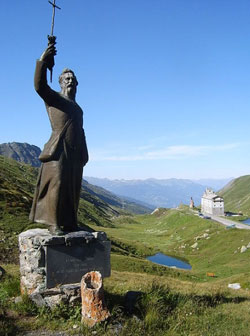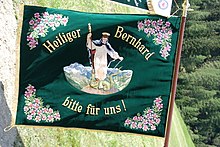
Feastday: May 28
Patron: of mountaineers, skiers, the Alps
Birth: 923
Death: 1008
Bernard of Montjoux was probably born in Italy. He became a priest, was made Vicar General of Aosta, and spent more than four decades doing missionary work in the Alps. He built schools and churches in the diocese but is especially remembered for two Alpine hospices he built to aid lost travelers in the mountain passes named Great and Little Bernard, after him. The men who ran them in time became Augustinian canons regular and built a monastery. The Order continued into the twentieth century. He was proclaimed the patron saint of Alpinists and mountain climbers by Pope Pius XI in 1923. He is sometimes fallaciously referred to as Bernard of Menthon and the son of Count Richard of Menthon, which he was not. His feast day is May 28th.
Bernard became patron and protector of skiers because of his four decades spent in missionary work throughout the Alps.
Bernard of Montjoux (Italian: San Bernardo di Mentone; Latin: Bernardus; German: Bernhard) was an Italian canon regular and founder of the Great St Bernard Hospice, and its associated Canons Regular of the Hospitaller Congregation of Great Saint Bernard.
Life
Early life
Bernard was born probably in the Château de Menthon, near Annecy, then in the County of Savoy, a part of the Kingdom of Burgundy. He was descended from a rich and noble family and received a thorough education in Paris. When he had reached adulthood, he decided to devote himself to the service of the Church and refused an honorable marriage proposed by his father. (In popular legend it is said that he had to sneak out of the castle on the night before an arranged wedding, and that during his flight from the castle, he threw himself from his window, only to be caught by angels and lowered gently to the ground 40 feet (12 meters) below.)
Placing himself under the direction of Peter, the Archdeacon of Aosta, under whose guidance he rapidly progressed, Bernard was ordained a priest and worked as a missionary in the mountain villages. Later, on account of his learning and virtue, he was appointed to succeed his mentor as archdeacon of the cathedral, giving him charge of the government of the diocese, directly under the bishop.
For 42 years, he continued to preach the Gospel to these people and even into many cantons of Lombardy, effecting numerous conversions and working many miracles. The last act of St. Bernard's life was the reconciliation of two noblemen whose strife threatened a fatal outcome. He died in June 1081 in the Imperial Free City of Novara and was interred in the monastery of St. Lawrence.
St Bernard's Passes
Main articles: Great St. Bernard Pass and Little St. Bernard Pass Great St. Bernard Pass, 2469 m, August 2003
Great St. Bernard Pass, 2469 m, August 2003
Since the most ancient times there has been a path across the Pennine Alps leading from the Aosta Valley to the Swiss canton of Valais. The traditional route of this pass is covered with perpetual snow from seven to eight feet deep, and drifts sometimes accumulate to the height of forty feet. Although the pass was extremely dangerous, especially in the springtime on account of avalanches, it was often used by French and German pilgrims on their way to Rome.
In his office as archdeacon, Bernard had the charge of caring for the poor and travelers. For their convenience and protection, Bernard founded a canonry and hostel at the highest point of the pass, 8,000 feet above sea-level, in the year 1050, at the site which has come to bear his name. A few years later he established another hostel on the Little St. Bernard Pass, a mountain saddle in the Graian Alps, 7,076 feet above sea-level. Both were placed in charge of communities of canons regular, after papal approval had been obtained by Bernard during a visit to Rome. The new community was placed under the patronage of Nicholas of Myra, patron saint of travelers.
Today the tunnel and modern technology have made rescue operations at the pass mainly unnecessary. The dogs were put up for sale in 2004 because of the high cost of maintenance and were promptly bought by foundations created for the purpose.
Legacy
 Saint Bernard on the flag of the Tyrolean Alpine Guard, detachment Villgraten valley
Saint Bernard on the flag of the Tyrolean Alpine Guard, detachment Villgraten valley
These hostels were renowned for the generous hospitality extended to all travelers over the Great and Little St. Bernard, so called in honor of the founder of these charitable institutions. At all seasons of the year, but especially during heavy snow-storms, the canons, later accompanied by their well-trained dogs, the common herding dogs of the Valais ("St Bernards" are attested from the 17th century), went out in search of victims who might have succumbed to the severity of the weather. They offered food, clothing, and shelter to the unfortunate travelers and took care of the dead. They depended on gifts and collections for sustenance.
As of 2012 the congregation consisted of around 35 professed members, the majority of whom live at the hostel while some provide pastoral care to neighboring parishes. St. Bernard dogs are still on the site as pets; helicopters are used in rescue operations today.
Although venerated from the 12th century in such places of northern Italy as Aosta, Novara and Brescia, Bernard was not formally recognized as a saint until his canonization by Pope Innocent XI in 1681. His feast is celebrated on 28 May or June 15 (Roman Martyrology). Pope Pius XI confirmed Bernard as the patron saint of the Alps in 1923. His image appears in the flag of some detachments of the Tyrolean Alpine Guard. He is also the patron saint of skiing, snowboarding, hiking, backpacking, mountaineering.
Saint Bernard's Catholic Church in Saranac Lake, New York is named for him.





